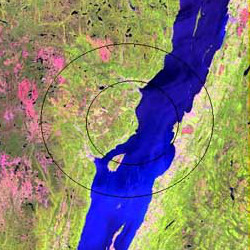List of impact structures on Earth

This list of impact structures (including impact craters) on Earth contains the majority of the 194+ confirmed impact structures given in the Earth Impact Database as of 2024.
Alphabetical lists for different continents can be found under Impact structures by continent below.
Unconfirmed structures can be found at List of possible impact structures on Earth.
Confirmed impact structures listed by size and age
These features were caused by the collision of meteors (consisting of large fragments of asteroids) or comets (consisting of ice, dust particles and rocky fragments) with the Earth. For eroded or buried craters, the stated diameter typically refers to the best available estimate of the original rim diameter, and may not correspond to present surface features. Time units are either in ka (thousands) or Ma (millions) of years.
10 ka or less
Less than ten thousand years old, and with a diameter of 100 m (330 ft) or more. The EID lists fewer than ten such craters, and the largest in the last 100,000 years (100 ka) is the 4.5 km (2.8 mi) Rio Cuarto crater in Argentina. However, there is some uncertainty regarding its origins and age, with some sources giving it as < 10 ka while the EID gives a broader < 100 ka.
The Kaali impacts (c. 1500 BC) during the Nordic Bronze Age may have influenced Estonian and Finnish mythology, the Campo del Cielo (c. 2500 BC) could be in the legends of some Native Argentine tribes, while Henbury (c. 2700 BC) has figured in Australian Aboriginal oral traditions.


The EID gives a size of about 50 m (160 ft) for Campo del Cielo, but other sources quote 100 m (330 ft).
10 ka to 1 Ma
From between 10 thousand years and one million years ago, and with a diameter of less than one km (0.62 mi):
From between ten thousand years and one million years ago, and with a diameter of one km (0.62 mi) or more. The largest in the last one million years is the 14-kilometre (8.7 mi) Zhamanshin crater in Kazakhstan and has been described as being capable of producing a nuclear-like winter.
The source of the enormous Australasian strewnfield (c. 780 ka) is a currently undiscovered crater probably located in Southeast Asia.


1 Ma to 10 Ma


From between 1 and 10 million years ago. The large but apparently craterless Eltanin impact (2.5 Ma) into the Pacific Ocean has been suggested as contributing to the glaciations and cooling during the Pliocene.
10 Ma or more
Most recorded impact craters are over 10 million years old, or have widely uncertain ages. The Chicxulub impact has been widely considered the most likely cause for the Cretaceous–Paleogene mass extinction, with some scholars linking other impacts like the Popigai impact in Russia and the Chesapeake Bay impact to later extinction events, though the causal relationship has been questioned.







Inferred impact events
Some impact events are only known from events like layers of spherules or tektites generated by the impact recorded in contemporary rocks, and their impact structures may no longer exist.
Sublists and statistics of impact structures by continent
As of 2022[update], the Earth Impact Database (EID) contains 190 confirmed impact structures. The table below is arranged by the continent's percentage of the Earth's land area, and where Asian and Russian structures are grouped together per EID convention. The global distribution of known impact structures apparently shows a surprising asymmetry, with the small but well-funded European continent having a large percentage of confirmed impact structures. It is suggested this situation is an artifact, highlighting the importance of intensifying research in less studied areas like Antarctica, South America and elsewhere.
Links in the column "Continent" will give a list of craters for that continent.
See also
- Bolide – Extremely bright meteor
- Earth Impact Database – Database of impact structures on Earth
- Extinction event – Widespread and rapid decrease in the biodiversity on Earth
- Impact event – Collision of two astronomical objects
- Impact Field Studies Group
- List of craters in the Solar System
- List of largest craters in the Solar System
- List of possible impact structures on Earth
- Traces of Catastrophe – Comprehensive technical reference on the science of impact craters
- Giant-impact hypothesis – Hypothesis of the formation of the Moon
- Deniliquin multiple-ring feature – Buried feature in southeast Australia, suggested to be an impact structure (520 km-diameter crater would be the largest one on Earth)
References
Further reading
- Flamini, Enrico; Di Martino, Mario; Coletta, Alessandro, eds. (2019). Encyclopedic Atlas of Terrestrial Impact Craters. Cham, Switzerland: Springer. ISBN 978-3-030-05449-6.
- Grieve, Wood, Garvin, McLaughlin, McHone, Jr. (1988) Astronaut’s Guidebook to Terrestrial Impact Craters Technical Report 88-03 Lunar and Planetary Institute
External links
- Impact Database (formerly Suspected Earth Impact Sites list) maintained by David Rajmon for Impact Field Studies Group, US
- Impact Meteor Crater Viewer Google Maps Page with Locations of Meteor Craters around the world
- Impact Craters at Lunar and Planetary Institute